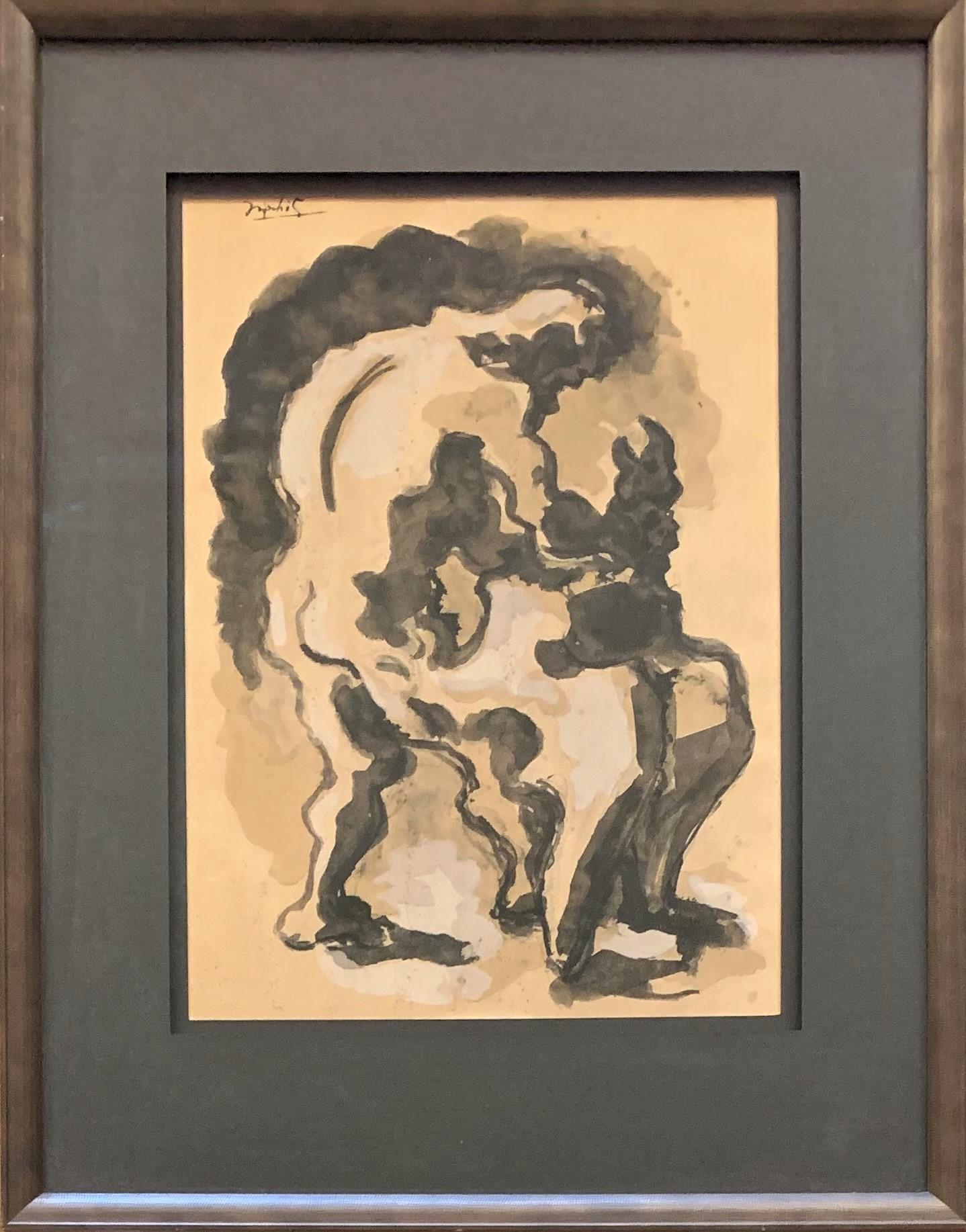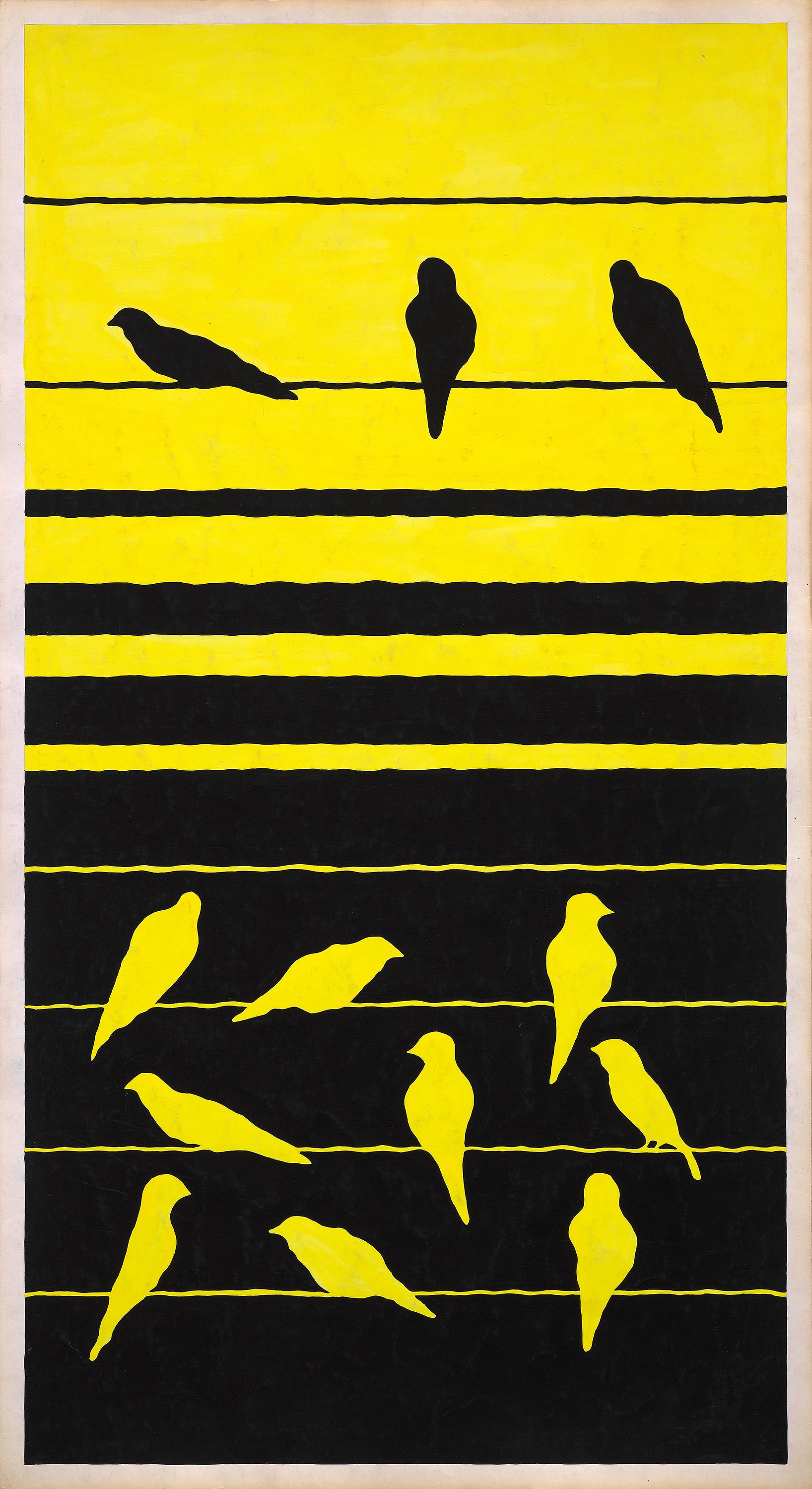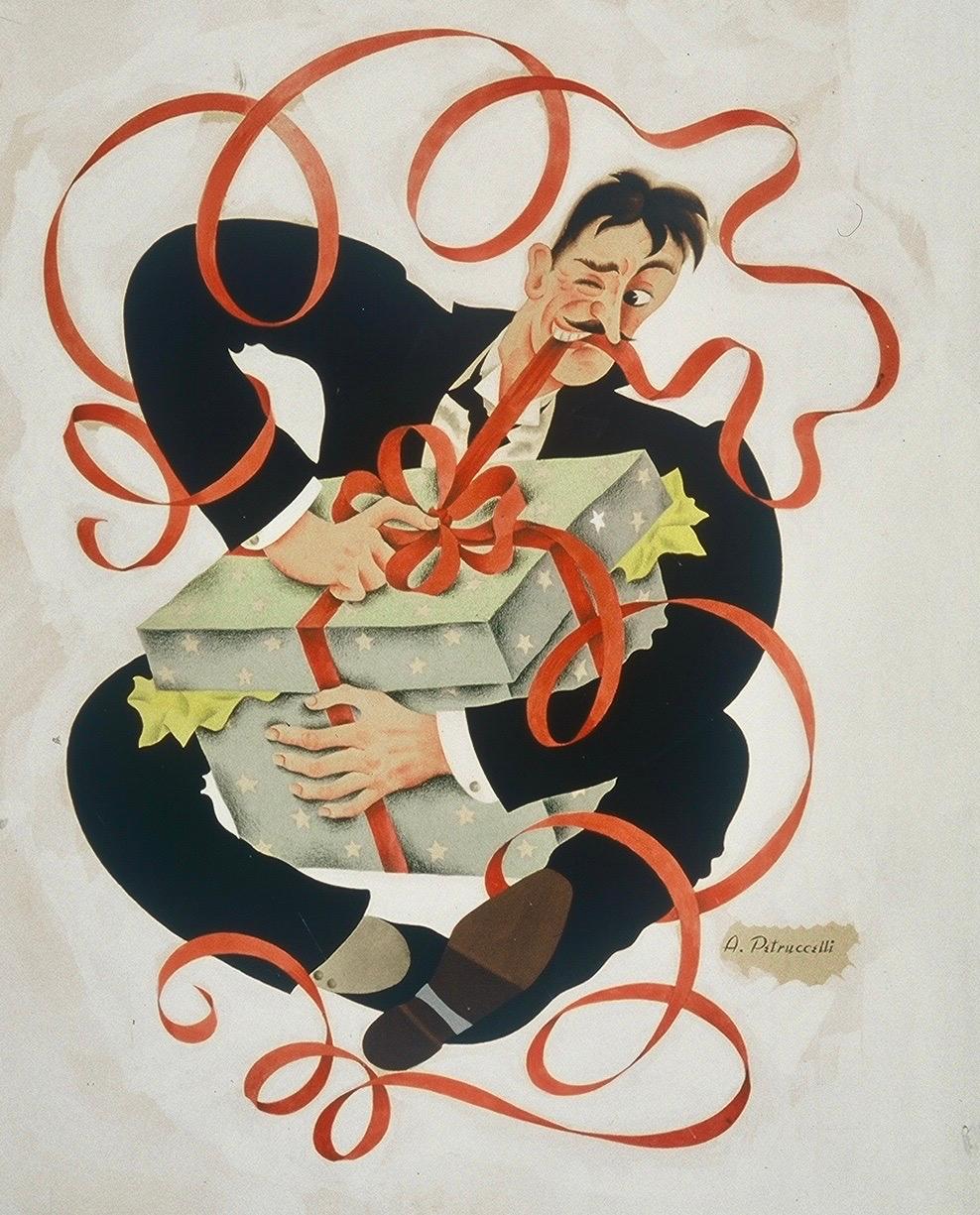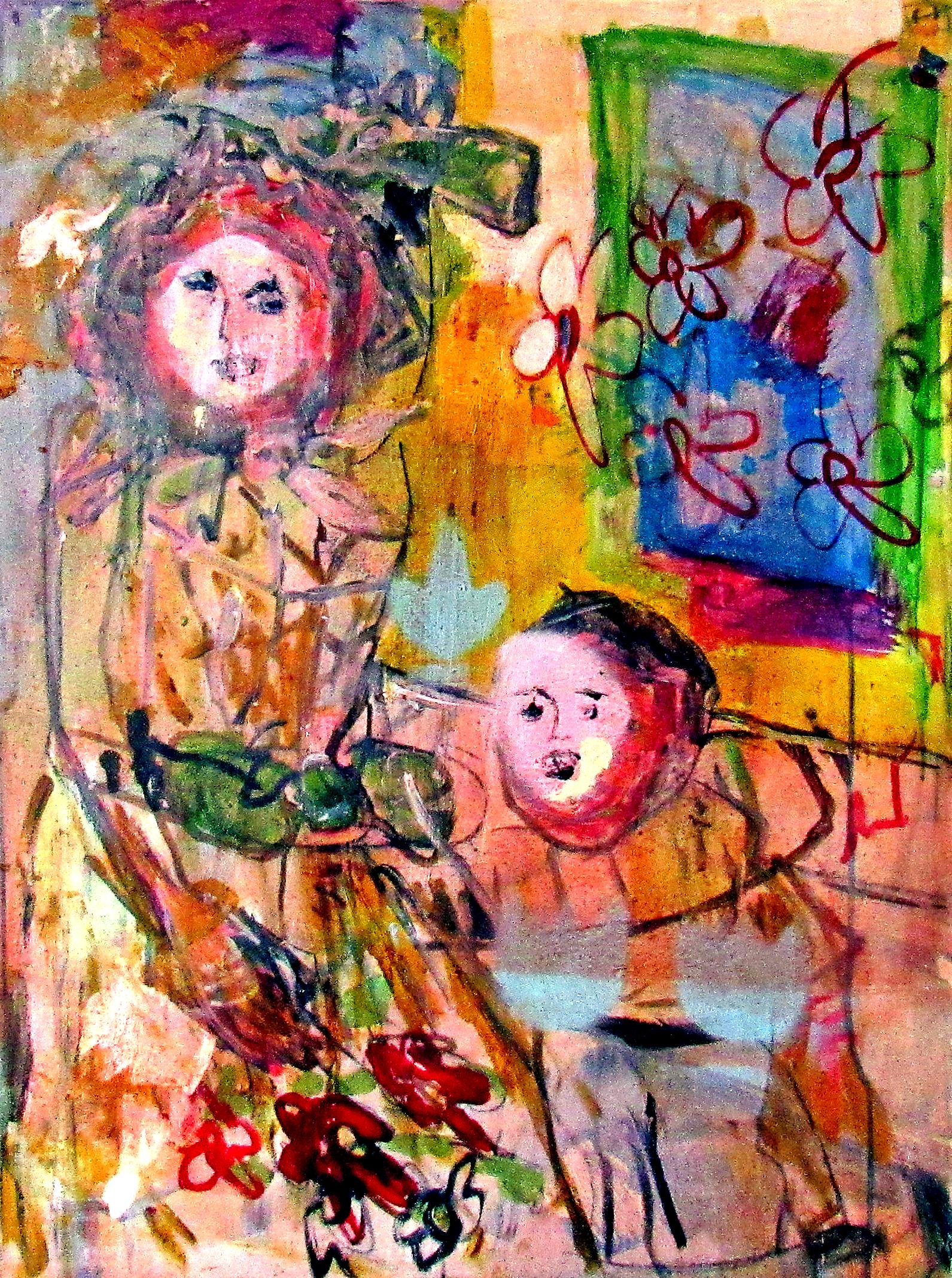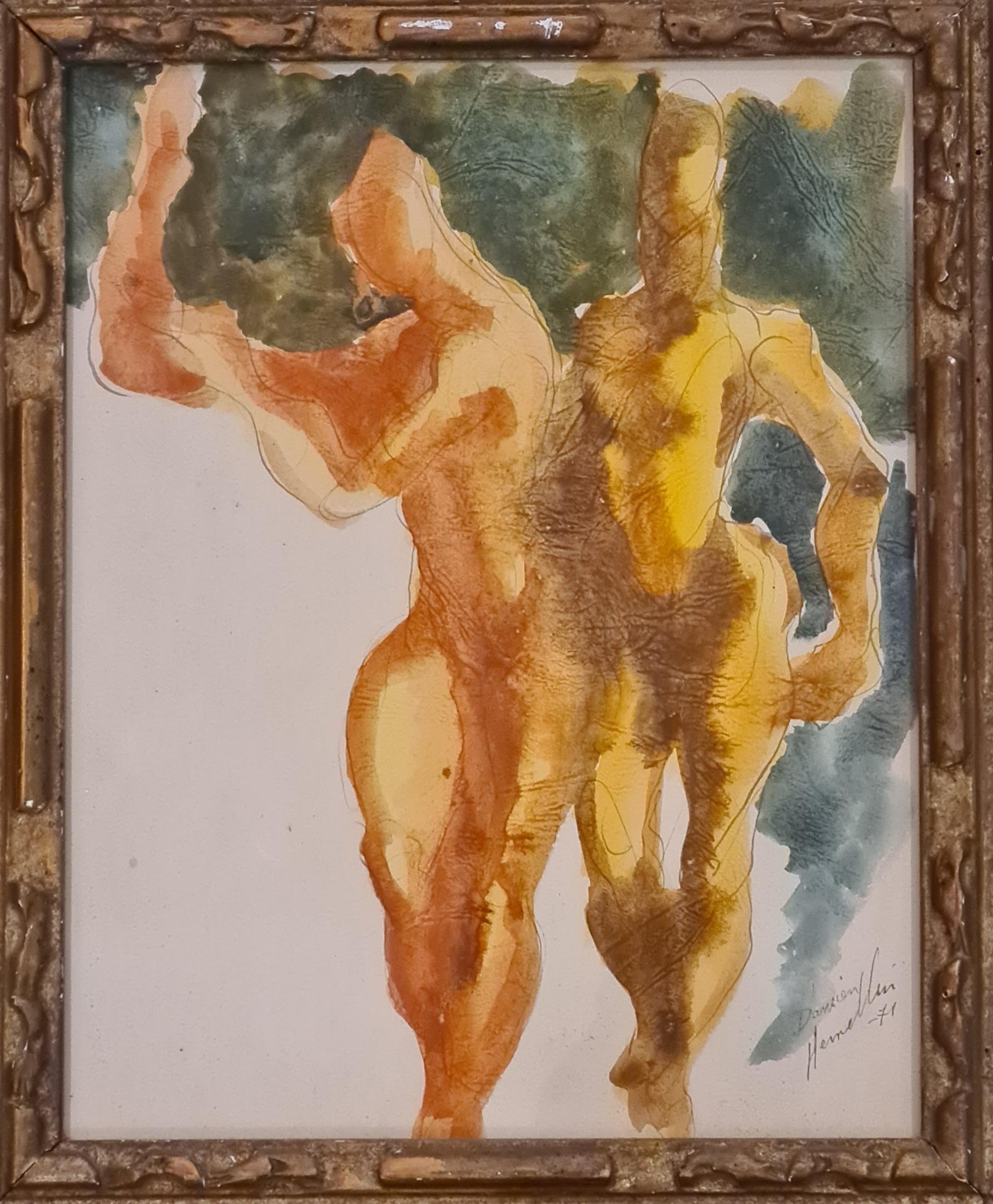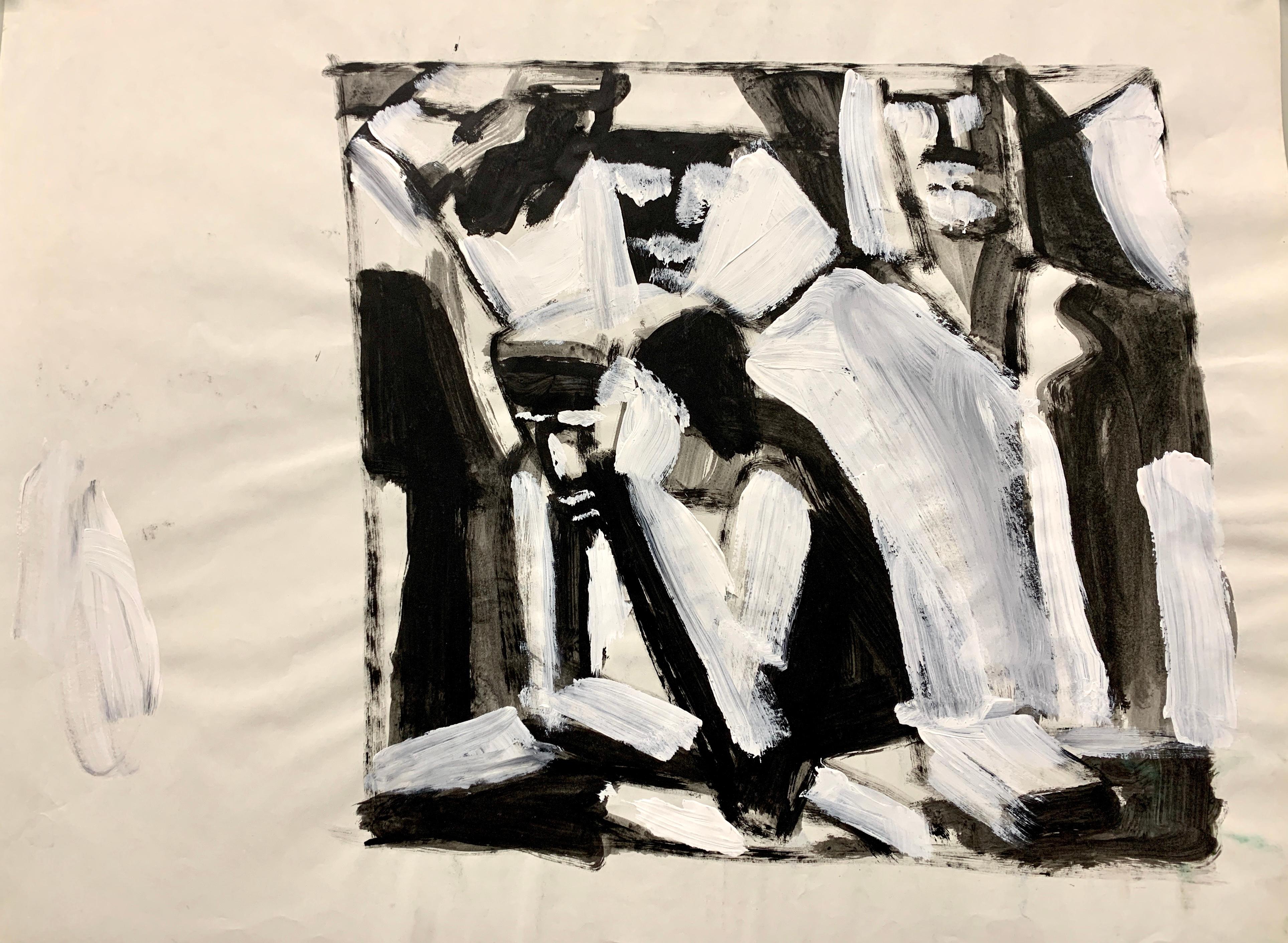Items Similar to Modernist American Judaica Painting Synagogue Interior Ladies Section WPA Era
Want more images or videos?
Request additional images or videos from the seller
1 of 15
Ervin B. NussbaumModernist American Judaica Painting Synagogue Interior Ladies Section WPA Era
About the Item
Titled Torah Service, hand signed on Arches archival paper.
In this painting, Nussbaum portrays a joyful holiday celebration of the Torah reading in the synagogue in a sketch-like manner without focusing on any specific details. The vibrant colors used in this painting seem to overlay each other without being previous mixed. Woman are visible in the gallery in a semi-abstract manner using vibrant colors in a gestural manner. This artwork exemplifies the artist's oeuvre and concentration in Hebraic themes.
Ervin B. Nussbaum was born in Columbus, Ohio on November 11, 1914. His father, Marger, had arrived as part of the great Russian Diaspora of the time, when many Jewish families settled in Ohio, particularly in the Columbus area.
Nussbaum attended Ohio State University during the Great Depression and continued to live in Ohio until America’s involvement in World War II. His oil painting The End of John Brown, which depicts a fictionalization of the American abolitionist’s final hours, won first prize at the Central Ohio Competition in 1941. The piece then toured the country stopping at the San Francisco Museum, the Butler Art Institute, the Philadelphia Academy and the Corcoran Gallery. Donated in 2001, the painting is now part of the permanent collection at the Torrington Historical Society in Torrington, Connecticut, John Brown’s birthplace.
When the war began, Ervin, along with some 40,000 other men of all faiths, became part of the conscientious objector program known as the Civil Public Service. He spent the years 1942 through 1946 interned in government camps from New Hampshire to Maryland, working in public services such as forestry and hurricane cleanup. Many other objectors housed alongside him were of artistic inclination and shared Nussbaum’s conviction of peace, so artistic pursuits were common within these camps.
During these early years, his paintings followed a somewhat whimsical figurative style and leaned towards patriotic and Hebraic themes. In time, these themes began to take on an almost Cubist feel and eventually leaned toward complete abstraction.
Upon his release from his voluntary conscription as a CPS, Nussbaum moved to New York where he frequently painted semi-abstract landscapes in the local parks, throughout the New England countryside, and at the shorelines. He especially enjoyed painting in the woodland tranquility of Inwood Park in northern Manhattan. He paid special attention to the park’s bird life, which would soon become a new favorite subject. Their graceful movement inspired his creation of a series of avian sculptures in wood, metal or mixed medias.
In 1951, he met the dynamic young actress, playwright, musician, and graphic artist Muriel Leventhal. They married and moved to Norwalk, Connecticut in 1959. Nussbaum continued to work in a variety of media and showed regularly in many different galleries throughout Connecticut. His bronze sculpture Three Girls on a Flower was commissioned by the Trumbull Library and a wood bas-relief was created for the sanctuary at the Yonkers Temple Emanuel. Nussbaum would remain in Norwalk until his death in 1996. It is by a clearly skilled hand and in the tradition of the great Judaic masters such as, Sigmund Menkes, Arthur Kolnik, Tully Filmus, Ben Zion, Ben Shahn, Marc Chagall and William Gropper.
When contemplating the work of Ervin Nussbaum, we find the soul of a man set in principles of profound religious and patriotic convictions as well as a deep abiding love of nature. His art shows us the evolution of the man through the evolution of the styles he undertook during his lifetime; from figurative, to cubist, to complete abstraction; from oils, to charcoal, to a mixture of media. His works are left to us in museums across the United States, as well as in countless private collections in the U.S. and abroad.
- Creator:Ervin B. Nussbaum (1914-1996, American)
- Dimensions:Height: 22.5 in (57.15 cm)Width: 30.75 in (78.11 cm)Depth: 0.1 in (2.54 mm)
- Medium:
- Movement & Style:
- Period:
- Condition:good. unframed.
- Gallery Location:Surfside, FL
- Reference Number:
About the Seller
4.9
Platinum Seller
These expertly vetted sellers are 1stDibs' most experienced sellers and are rated highest by our customers.
Established in 1995
1stDibs seller since 2014
1,548 sales on 1stDibs
Typical response time: 1 hour
- ShippingRetrieving quote...Ships From: Surfside, FL
- Return PolicyA return for this item may be initiated within 3 days of delivery.
More From This SellerView All
- Modernist American Judaica Painting Purim, Dancing on HamanBy Ervin B. NussbaumLocated in Surfside, FLIn this painting, Nussbaum portrays a joyful holiday celebration of the megillah reading in the synagogue in a sketch-like manner without focusing on any specific details. The vibran...Category
1970s Modern Figurative Paintings
MaterialsGouache
- Rare German Israeli Surrealist Judaica Abstract Gouache Watercolor PaintingBy Naftali BezemLocated in Surfside, FLA Surrealist Judaica scene of a bearded man (Rabbi) in a boat with Shabbat candlesticks. Sight size: 17.75" x 22.5". Overall size with frame: 26.5" x31.5" Naftali Bezem (Hebrew: נפתלי בזם; born November 27, 1924) is an Israeli painter, muralist, and sculptor. Bezem was born in Essen, Germany, in 1924. His early adolescence was spent under Nazi oppression, in constant fear for the safety of his parents, who perished in the Holocaust in the Polish Auschwitz concentration camp. Naftali emigrated to Mandate Palestine in 1939, at the age of fourteen with a Youth Aliyah group. From 1943 to 1946, he studied art, painting and sculpture, at the Bezalel Academy of Art and Design in Jerusalem with Israeli painter Mordecai Ardon. He then spent three years studying in Paris. He was published by Editions Empreinte in Paris, France. They published, Jean Michel Folon, Sempe, Raoul Ubac, Raymond Savignac, Cesar, Bengt Lindstrom , Paul Aizpiri and many other modern masters. In addition to painting and sculpture, Bezem created murals, wall reliefs, tapestry wall hangings, and stained glass windows. His most famous public works include a wall relief at Yad Vashem in Jerusalem and the ceiling mural in the main reception room at the President's Residence, Jerusalem. Awards and recognition In 1957, Bezem was a co-recipient of the Dizengoff Prize for Painting Group Exhibitions Orit Art Gallery, Tel Aviv Artists: Yosef Zaritsky, Marcel Janco, Lea Nikel, Robert Baser, Bezem, Michael Druks, Israeli Painting (Watercolors and Gouache) Artists: Pinchas Abramovich, Bezem, Naftali Nachum Gutman, Haim Gliksberg, Mordechai Levanon, Avigdor Stematsky, Avshalom Okashi...Category
1970s Modern Abstract Paintings
MaterialsWatercolor, Gouache, Ink
- Romanian Modernist Gouache Painting Of Buildings And Boats - Jean DavidBy Jean DavidLocated in Surfside, FLJean David was a painter and designer, known for his contributions to the Romanian avant-garde and to the early modernist art of Israel (then recently founded). He was the first Israeli artist to be inducted into the illustrious Alliance Graphique Nationale in 1954. He had studied between 1927 and 1937 at various art academies in Paris. In 1929 he participated for the first time at a collective exhibition in Bucharest and in 1933 he had his first personal exhibition (in the same city). In the early '30s he was a member of the Surrealist group "unu" (meaning "one"). In 1942, he left Romania in a boat with 12 other Jews, including Theodor Brauner, the brother of Victor Brauner. After being captured by British authorities in Cyprus, he managed to reach Palestine in 1944. In 1949 he went to live in Jerusalem, where he was active in developing ceramic arts, sculpture works in copper, and artistic tapestry wall hangings under the auspices of the Ministry of Trade and Industry. Together with Marcel Janco, he founded in Israel the artist village known as Ein Hod. He also gained much reputation as a muralist and graphic and poster designer, having designed numerous posters and other works for the El Al air company, Maccabiah games, Zim shipping and The Israel tourist industry. David’s primary importance was in the design of posters. He used a wildly colorful decorative style in his art, which combined illustration, caricature, and national figures. In addition he designed wall hangings for “Maskit,” and also worked in the decoration of public buildings. His paintings had elements of Surrealism and included images from nature and landscapes. Similar in style to David Klein and the Polish Cyrk posters. Forms From Israel, Mounting Exhibition, USA, 1958 Artists: El Hanani (Sapozhnikow), Arie Azaz, Nehemiah Boris Carmi, Hanna Harag Zunz, David, Jean David Gumbel, Keiner Forcheimer, Julia Mansfeld, Al Merom, Peter Mayer, Jean Palombo...Category
Mid-20th Century Modern Figurative Paintings
MaterialsGouache, Paper
- Large Gouache Original Painting Mother & Daughter Sandu Liberman Israeli JudaicaBy Sandu LibermanLocated in Surfside, FLframed 36 X 28 board 30 X 21.75 Sandu Liberman (Romanian-Israeli) was born in Yasi, Romania in 1923. between 1946 and 1953 he took part in the state art shows in Bucharest. in 1952 ...Category
20th Century Modern Figurative Paintings
MaterialsGouache, Paper
- Simka Simkhovitch WPA Artist Oil Painting Gouache American Modernist PowerlineBy Simka SimkhovitchLocated in Surfside, FLSimka Simkhovitch (Russian/American 1893 - 1949) This came with a small grouping from the artist's family, some were hand signed some were not. These were studies for larger paintings. Simka Simkhovitch (Симха Файбусович Симхович) (aka Simka Faibusovich Simkhovich) (Novozybkov, Russia May 21, 1885 O.S./June 2, 1885 N.S.—Greenwich, Connecticut February 25, 1949) was a Ukrainian-Russian Jewish artist and immigrant to the United States. He painted theater scenery in his early career and then had several showings in galleries in New York City. Winning Works Progress Administration (WPA) commissions in the 1930s, he completed murals for the post offices in Jackson, Mississippi and Beaufort, North Carolina. His works are in the permanent collections of the Dallas Museum of Art, the National Museum of American Art and the Whitney Museum of American Art. Born outside Kyiv (Petrograd Ukraine) into a Jewish family who owned a small department store. During a severe case of measles when he was seven, Simcha Simchovitch sketched the views outside his window and decided to become an artist, over his father's objections. Beginning in 1905, he studied at the Grekov Odessa Art School and upon completion of his studies in 1911 received a recommendation to be admitted to the Imperial Academy of Arts. Though he enrolled to begin classes in architecture, painting, and sculpture at the Imperial Academy, he was dropped from the school roster in December because of the quota on the number of Jewish students and drafted into the army. Simchovitch served as a private in the 175th Infantry Regiment Baturyn [ru] until his demobilization in 1912. Re-enrolling in the Imperial Academy, he audited classes. Simka Simkhovitch exhibited paintings and sculptures in 1918 as part of an exhibition of Jewish artists and in 1919 placed 1st in the competition "The Great Russian Revolution" with a painting called "Russian Revolution" which was hung in the State Museum of Revolution. In 1922, Simkha Simkhovitch exhibited at the International Book Fair in Florence (Italian: Fiera Internazionale del Libro di Firenze). In 1924, Simkhovitch came to the United States to make illustrations for Soviet textbooks and decided to immigrate instead. Initially he supported himself by doing commercial art and a few portrait commissions. In 1927, he was hired to paint a screen for a scene in the play "The Command to Love" by Fritz Gottwald and Rudolph Lothar which was playing at the Longacre Theatre on Broadway. Art dealers began clamoring for the screen and Simkhovitch began a career as a screen painter for the theater. Catching the attention of the screenwriter, Ernest Pascal, he worked as an illustrator for Pascal, who then introduced him to gallery owner, Marie Sterner. Simkhovitch's works appeared at the Marie Sterner Gallery beginning with a 1927 exhibit and were repeated the following year. Simkhovitch had an exhibit in 1929 at Sterner's on circus paintings. In 1931, he held a showing of works at the Helen Hackett Gallery, in New York City and later that same year he was one of the featured artists of a special exhibit in San Francisco at the California Palace of the Legion of Honor in Lincoln Park. The exhibit was coordinated by Marie Sterner and included four watercolors, including one titled "Nudes". He is of the generation of Russian Soviet artists such as Isaac Pailes, Serge Charchoune, Marc Chagall, Chana Orloff, Isaac Ilyich Levitan, and Ossip Zadkine. In 1936, Simkhovitch was selected to complete the mural for the WPA Post office project in Jackson, Mississippi. The mural was hung in the post office and courthouse in 1938 depicted a plantation theme. Painted on the wall behind the judge’s bench, “Pursuits of Life in Mississippi”, a depiction of black workers engaged in manual labor amid scenes of white professionals and socialites, was eventually covered over in later years during renovations due to its stereotypical African American imagery. Simka painted what he thought was typical of Jackson. His impression of pre-civil rights Mississippi was evidently Greek Revival column houses, weeping willow trees, working class families, and the oppression of African Americans. He painted African American men picking cotton, while a white man took account of the harvest and a white judge advised a white family, calling it Pursuits of Life in Mississippi. Though clearly endorsed by the government and initially generally well-received, the mural soon raised concerns with locals as the climate toward racial segregation began to change. The main concern was whether depictions that show African Americans in subjugated societal roles should be featured in a courtroom. The following year, his painting "Holiday" won praise at an exhibition in Lincoln, Nebraska. In 1940, Simkhovitch's second WPA post office project was completed when four murals, "The Cape Lookout Lighthouse and the Orville W. Mail Boat", "The Wreck of the Crissie Wright", "Sand Ponies" and "Canada Geese" were installed in Beaufort, North Carolina. The works were commissioned in 1938 and did not generate the controversy that the Jackson mural had. The main mural is "The Wreck of the Crissie Wright" and depicts a shipwreck which had occurred in Beaufort in 1866. "The Cape Lookout Lighthouse and the Orville W. Mail Boat" depicted the lighthouse built in 1859 and the mail boat that was running mail during the time which Simkhovitch was there. The boat ran mail for the area until 1957. "Sand Ponies" shows the wild horses common to the North Carolina barrier islands and "Canada Geese" showed the importance of hunting and fishing in the area. All four murals were restored in the 1990s by Elisabeth Speight, daughter of two other WPA muralists, Francis Speight...Category
1930s American Modern Landscape Paintings
MaterialsGouache, Oil, Board
- 2 Sided Expressionist Detroit Modernist Painting Female Nude, Night Cruise ShipLocated in Surfside, FLThis is a two sided painting. Nude reclining woman and a ship lit at night. Harold Cohn (1908 - 1982) Harold Cohn was active/lived in New Jersey, Michigan. Harold Cohn is known fo...Category
Mid-20th Century Modern Nude Paintings
MaterialsWatercolor, Gouache
You May Also Like
- Prometheus Conquering the Vulture, Gouache Painting, Modern & Cubist 1938By Jacques LipchitzLocated in Saint Augustine, FLArtist: Jacques Lipchitz (1891-1973, French) Title: Prometheus & the Vulture Medium: Gouache & Pencil on Paper Movement: Modern, Cubist Year of Work: Circa 1938 Signature: Top Left ...Category
1930s Modern Figurative Paintings
MaterialsPaper, Gouache, Pencil
- Original 70's Hand Painted Textile Design Gouache Yellow & Black Color on PaperLocated in ALCOY/ALCOI, ESBirds design. Sealed on the back with the design studio name and number 98 We offer a small number of these original illustration designs by this design studio based in Alcoy (Spain)...Category
1970s Modern Animal Drawings and Watercolors
MaterialsGouache, Paper
- Original Painting. Colliers Cover Published. American Scene Christmas ModernBy Antonio PetruccelliLocated in New York, NYOriginal Painting. Colliers Cover Published American Scene Christmas Modern Antonio Petruccelli (1907 - 1994) Man with Ribbon Colliers published,...Category
1930s American Modern Figurative Paintings
MaterialsGouache, Board
- Rosemarie & Young Jim, bright colors abstracted portrait interior flowersBy C. DimitriLocated in Brooklyn, NYPanel painting has bright colors abstracted portrait faces, interior, flowers, loose visible gestural brushstrokes C. Dimitri says this painting is a tribute to a painter friend of ...Category
2010s Modern Figurative Paintings
MaterialsOil, Gouache, Panel
- The Dancers, French Late Mid Century Gouache on Textured PaperLocated in Cotignac, FRLate Mid Century French watercolour and Gouache on handmade paper of a pair of dancers by Damien Hermellin. Signed and dated bottom right. Pres...Category
1970s Modern Figurative Drawings and Watercolors
MaterialsPaper, Watercolor, Gouache, Handmade Paper
- 1950s "Group Meeting" Mid Century Figurative Gouache University of ParisBy Donald StacyLocated in Arp, TXDonald Stacy "Group Meeting" c.1950s Gouache paint on paper 24" x 18'" unframed Unsigned Came from artist's estate Donald Stacy (1925-2011) New Jersey Studied: Newark School of Fin...Category
Mid-20th Century American Modern Figurative Paintings
MaterialsPaper, Gouache
